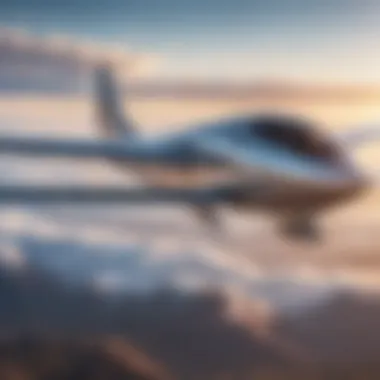Understanding the Principles of Glider Flight


Intro
The study of glider flight intertwines principles of physics, engineering, and environmental science. Gliders, often seen soaring gracefully through the skies, rely on natural aerodynamic forces for sustained flight. Unlike powered aircraft, they possess no engines, and their maneuverability stems from the careful design of their wings and the strategic use of environmental elements like thermals and wind currents. This exploration aims to delve into the intricate dynamics that govern glider flight.
Understanding these mechanics is crucial for students, researchers, educators, and professionals interested in aviation and aerodynamics. The following sections will unfold the various aspects of glider flight, detailing the key aerodynamic forces, design characteristics, and external influences that contribute to effective navigation in the air.
Prelims to Glider Flight
Understanding glider flight is essential for anyone interested in aviation and the principles of aerodynamics. Gliders provide insight into how aircraft can achieve sustained flight without propulsion, relying instead on natural forces and carefully designed structures. This section serves as an introduction, highlighting the significance and benefits of studying gliding mechanics.
The ability to glide efficiently is not only a test of engineering capabilities but also an embodiment of physics in action. Students and professionals in aerospace engineering, physics, and environmental sciences can find value in understanding these principles. Moreover, gliding serves as a practical application for theoretical concepts like lift, drag, and energy conservation, making it an ideal subject for deeper exploration.
With the advent of technology, the capabilities of gliding have expanded. Modern gliders utilize advancements in materials and design that improve performance and safety. This article aims to unravel those complexities, providing a thorough overview of glider flight mechanics. Readers will gain insight into how gliders have evolved and the key factors that contribute to their effectiveness in the air.
By understanding the elements that underlie glider flight, one can appreciate not only the skill involved in piloting a glider but also the intricate balance of forces that allow for soaring in the sky with grace.
Overview of Gliding
Gliding is the act of flying through the air without the use of an engine. This makes it distinct from powered flight, where engines provide thrust. Gliders are designed to take full advantage of their aerodynamic properties, enabling them to travel long distances or hover in the air using only the surrounding atmosphere. Key elements include:
- Airflow: Gliders depend on the airflow around their wings to create lift.
- Lift and Drag: The interaction between these two aerodynamic forces is vital in determining how well a glider performs.
In gliding, pilots must constantly adapt their strategies to changing air currents. For instance, thermals, or rising columns of warm air, can be utilized to ascend, thus extending flight time. By navigating effectively through these currents, pilots can maximize their gliding distances and altitudes.
History of Gliders
The history of gliders is as fascinating as the flight itself. Early attempts at gliding date back centuries, with pioneers experimenting with various designs before achieving success. The timeline includes significant developments:
- Otto Lilienthal: In the late 19th century, he became one of the first individuals to make controlled glider flights. His work laid the groundwork for future aviation.
- Wright Brothers: Before they achieved powered flight, the Wright brothers focused extensively on glider design, improving lift and control.
Understanding this history provides context to current advancements. Modern gliders have evolved significantly from their predecessors, showcasing improvements in aerodynamics and materials that enhance performance and safety. This historical perspective enriches one's appreciation for the sport of gliding as well as the technological undertakings that continue to shape aviation.
Principles of Aerodynamics
Aerodynamics explains the behavior of air around the glider's structure, influencing performance and control. Mastery of these principles can not only improve flight efficiency but also enhance safety.
Understanding Lift
Bernoulli's Principle
Bernoulli's Principle expresses that an increase in the velocity of air results in a decrease in pressure. This concept is crucial because the design of a glider's wings takes advantage of this relationship. When air travels faster over the curved upper surface of the wing compared to the flatter lower surface, the difference in pressure generates lift. This is a preferred explanation because it clearly connects fluid dynamics to flight.
The unique feature of Bernoulli's Principle lies in its reliance on airspeed rather than angle. It emphasizes the importance of wing shape and the airflow around it. One of the main advantages is its simplicity in calculation, which allows for quick assessments of lift under varied conditions. However, it can be somewhat limited in scope, as it does not account for other factors like viscosity and the three-dimensional aspects of airflow.
Angle of Attack
The angle of attack refers to the angle between the wing's chord line and the oncoming air. This parameter is vital because it impacts the amount of lift generated. Increasing the angle of attack typically increases lift up to a certain point. Beyond this, a stall can occur, causing a sudden loss of lift.
One key characteristic of angle of attack is its direct influence on lift generation. It becomes particularly beneficial in manipulating lift during flight maneuvers. The ability to adjust angle of attack allows for precise control of the glider’s behavior in the air. The downside is that exceeding optimal angles can lead to aerodynamic stall, which poses risks, especially for novice pilots.
The Role of Drag
Induced Drag
Induced drag is a result of the generation of lift. As the wing creates lift by altering the pressure on each side, a side effect is induced drag, which increases with the angle of attack. In simple terms, as lift increases, so does induced drag.
A significant aspect of induced drag is its dependency on lift; its reduction is often a key consideration during flight planning. Because it arises naturally from lift, it is an unavoidable consequence for gliders. Its main disadvantage is that it can lead to reduced efficiency at higher angles of attack, which pilots must manage to maintain glide performance.


Parasite Drag
Parasite drag, in contrast, comes from the shape and surface texture of the glider. This type of drag increases with speed and is less wholly connected to lift than induced drag. It consists of three main components: form drag, skin friction drag, and interference drag.
Its primary characteristic is that it affects glider performance irrespective of lift generation. For pilots, minimizing parasite drag is essential for optimizing gliding distance and efficiency. The unique feature of parasite drag is that it can often be reduced through design improvements, such as smoother surfaces and streamlined shapes. The downside is that it becomes more pronounced at higher speeds, which can be a limiting factor in certain flying conditions.
Glider Design Features
The design of a glider is crucial for its performance, endurance, and handling characteristics. Glider design features encompass aspects like wing shape, materials, and control surfaces. Each element plays a vital role in optimizing flight performance, emphasizing the balance between efficiency and control. Understanding these features is imperative for both enthusiasts and practitioners in the field of gliding. This section will break down the distinct components that make gliders both functional and aerodynamic.
Wing Shape and Size
Aspect Ratio
The aspect ratio is defined as the ratio of the wingspan to the mean wing width. This dimension has significant implications for the glider's aerodynamics. A higher aspect ratio typically promotes better lift-to-drag performance, making gliders more efficient. Gliders with longer wings allow for reduced induced drag, which is crucial during long flights. For instance, sailplanes often feature high aspect ratio wings designed specifically for maximizing gliding distance.
The main characteristic of high aspect ratio wings is their slender shape, which provides less drag while enhancing lift. This design is advantageous in competitions and long-distance gliding scenarios. However, longer wings can lead to decreased maneuverability in turbulent conditions. Pilots must weigh the benefits of efficiency against the potential loss of responsiveness.
Wing Area
The wing area of a glider is the total surface area of the wings. This feature directly influences lift generation, with larger wing areas providing more lift while requiring less speed. A substantial wing area is particularly beneficial for gliders designed to operate in low-speed conditions or during early ascent.
The major characteristic of a larger wing area is the increased potential for lift at lower velocities. This makes it a preferred choice for training gliders or those aiming for stable, controlled flight. However, larger wing areas can also increase drag, leading to a trade-off between lift and efficiency. Moreover, aerodynamic optimization becomes essential to ensure that the performance is not compromised due to drag forces.
Materials Used
Common Materials
Gliders are constructed using advanced materials such as fiberglass, carbon fiber, and aluminum. These materials are selected for their strength-to-weight ratios, contributing to overall performance by reducing weight while ensuring structural integrity. Fiberglass is commonly used in many general glider designs due to its low cost and ease of production. Meanwhile, carbon fiber has become popular in high-performance gliders for its lightweight and high stiffness.
The key characteristic of these materials is durability while maintaining a low weight. This feature is essential for both recreational and competitive gliding, where every ounce matters. A disadvantage of certain materials, particularly when looking at cost, is that advanced composites such as carbon fiber can be expensive, which may limit access for some enthusiasts.
Impact on Performance
The choice of materials has a direct impact on the overall performance of a glider. Lighter materials enable faster climbs and longer glides. Additionally, weaker materials can result in structural limitations, impacting the glider's safety and longevity. Newer materials continue to emerge, influencing design and production trends.
The unique feature of modern materials lies in their ability to enhance performance metrics like speed and efficiency while minimizing weight. However, advances in material technology often require more sophisticated manufacturing processes that can increase production costs. Balancing material choice with budget constraints is a critical consideration for builders and designers.
Control Surfaces
Ailerons
Ailerons are essential control surfaces found on the trailing edge of the wings. They are used to control roll, allowing the glider to bank during turns. Ailerons work in opposition; when one is deflected upward, the other is deflected downward. This mechanism enables the glider to pivot about its longitudinal axis, which is crucial for maneuverability and flight stability.
The key aspect of ailerons is their ability to provide responsive control during flight. This quality makes them a necessary feature for all gliders, particularly those that require precision in flight paths during competitions or training. A potential downside is that poorly designed ailerons can cause adverse yaw, complicating turns.
Rudders and Elevators
Rudders and elevators are vital for controlling the yaw and pitch of the glider, respectively. The rudder is located on the vertical stabilizer while the elevator is found on the horizontal stabilizer. These surfaces ensure that pilots can adjust their flight path and attitude with precision.
The main characteristic of rudders and elevators is their influence on the stability and control of the glider. These surfaces are critical for effective flight performance, allowing pilots to manage their glider's orientation in response to external forces. A limitation of these components is that excessive sensitivity might lead to overcontrol, resulting in a loss of stability.
In summary, glider design features encompass various aspects that dictate a glider's functionality and performance in the skies. A thorough understanding of these elements is essential for anyone interested in the intricate balance of aerodynamics, materials, and control mechanics that define successful glider flight.
Flight Mechanics
Understanding flight mechanics is critical in appreciating how gliders operate effectively in the air. Flight mechanics refers to the study of the forces acting on an aircraft during flight, which includes aspects of stability, control, and maneuverability. For gliders, where powered propulsion is absent, knowledge of these mechanics can greatly influence performance and safety. The field encompasses various launching methods, gliding techniques, and environmental interactions to optimize the flight experience.
Launch Techniques


Launch techniques are vital for initiating a glider's flight. Each method has its unique characteristics that cater to different needs and circumstances.
Tow Launching
Tow launching involves a powered aircraft towing the glider to gain altitude. This technique offers several advantages, the most notable being the ability to reach significant heights quickly. A key characteristic of tow launching is its reliance on an experienced tow pilot and a robust towing system. This method is favored because it allows for consistent launches and the ability to choose the desired altitude and direction.
The unique feature of this method is its use of a tow rope, which connects the glider to the tow plane. While effective, it is essential to manage the tension in the rope; too much force can cause stress on the glider or even lead to equipment failure. Additionally, the glider must release the tow at a precise moment to ensure safe and controlled flight.
Advantages include gaining altitude rapidly and having a higher initial speed, which can help in locating thermals. However, the drawbacks are dependency on a suitable tow aircraft and potential issues with coordination between the two pilots.
Winch Launching
Winch launching utilizes a ground-based winch system to rapidly pull the glider into the air. This method is more economical compared to tow launching, as it does not rely on a powered aircraft for launching. A key characteristic of winch launching is the use of a spool to reel in a cable attached to the glider. This method is popular because it can be executed at various locations without needing extensive logistics.
The unique feature of winch launching is its ability to pull gliders more vertically than tow launching, which often results in a steeper ascent. It has clear advantages, such as reduced costs and less pre-launch coordination. However, it requires a significant amount of space along the launch line and effective communication among ground crew and pilots to avoid accidents.
Gliding Techniques
Once in the air, pilots employ various gliding techniques to maximize flight efficiency and enjoyment. Two prominent techniques are turning and banking, and thermal circling.
Turning and Banking
Turning and banking are fundamental aspects of glider maneuvering, allowing pilots to navigate airspace and find optimal flight paths. This technique's key characteristic is the use of ailerons to control the roll of the glider. It is a beneficial choice for making coordinated turns essential for staying aligned with thermals or avoiding obstacles.
The unique feature of turning and banking is its reliance on the glider's rudder and ailerons working in unison. Properly executed, this technique can enhance performance during flights, allowing pilots to maintain altitude while changing direction. However, improper use can lead to increased drag or even undesirable stall conditions.
Thermal Circling
Thermal circling is a technique where gliders ascend by utilizing rising columns of warm air known as thermals. This is a powerful method for extending flight duration without the need for constant propulsion. The key characteristic is identifying thermals, which can be challenging but rewarding when done correctly.
The unique feature of thermal circling is the ability to gain altitude simply by flying in a circular path within a thermal. This technique increases the chances of finding a sustainable lift, providing advantages for long-distance flights or competition scenarios. On the downside, misjudging thermal boundaries can lead to ineffective circling and wasted time, potentially affecting the overall flight plan.
Understanding these flight mechanics is essential for both novice and experienced pilots. Each technique has distinct characteristics, benefits, and considerations that ultimately contribute to a successful gliding experience.
In summary, grasping the nuances of launch and gliding techniques can fundamentally transform a pilot’s skills and approach to gliding. By integrating these techniques with a solid understanding of flight mechanics, gliders can navigate the skies efficiently.
Environmental Factors
Environmental factors play a critical role in the performance and effectiveness of glider flight. Understanding these elements allows pilots to make informed decisions about flight conditions, ensuring safety and maximizing efficiency during their gliding experience.
Thermals and Their Effects
Thermals are rising columns of warm air that provide essential lift for gliders. They are created when sunlight heats the ground, causing air above it to warm, rise, and expand. This upward movement can be keenly utilized by glider pilots to gain altitude. The strength and location of thermals vary depending on factors such as the landscape and time of day.
A pilot’s ability to locate and utilize thermals can mean the difference between a brief flight and an extended soaring experience. When a glider seeks out a thermal, it often circles within it, gaining height until the thermal dissipates or the pilot decides to navigate to another one.
Key benefits of thermals include:
- Sustained lift: Allowing longer flights without propulsion.
- Increased altitude: Helps gliders climb to higher altitudes for more extended distances.
However, thermals are not always easy to find. Pilots must be adept in reading the landscape and the weather, as well as understanding signs of thermal activity like cumulus clouds.
Wind and Weather Conditions
Wind and weather significantly influence gliding flight. Wind direction, speed, and atmospheric conditions determine how a glider interacts with these forces during flight.
Effects of Wind Direction
Wind direction is crucial for evaluating routing and landing strategies. A headwind can slow down a glider, impacting its glide ratio, while a tailwind can enhance speed but may complicate landings. Understanding the wind direction is an important skill for any glider pilot.


- Key characteristic of wind direction: It changes throughout the day based on temperature differences in the atmosphere.
- Unique feature: Wind can create lift when it encounters terrain, generating updrafts on the windward side of hills and ridges.
Pros of considering wind direction include:
- Better decision-making for takeoffs and landings.
- Increased flight efficiency by harnessing favorable winds.
Cloud Physics
Cloud physics plays an integral role in understanding visibility and thermal conditions for gliders. The presence of clouds can indicate areas of lift, especially cumulus clouds, which often signal nearby thermals.
- Key characteristic: Certain cloud patterns can forecast reliable thermal activity.
- Unique feature: Clouds help visualize shifts in wind patterns, enhancing pilots' ability to navigate safely.
Advantages of studying cloud physics include:
- Improved safety in navigation by anticipating changes in weather.
- The ability to identify ideal conditions for thermals leading to prolonged flights.
"Understanding the environmental factors in glider flight can greatly enhance both performance and safety. Knowledge of thermals, wind, and clouds is not just an advantage; it is essential for aspiring pilots."
Through integrating these environmental elements, glider pilots can master the art of soaring, leading to more enjoyable and successful flights.
Safety Considerations in Gliding
Safety is a primary concern in aviation, and gliding is no exception. Gliders offer a unique, engine-less flying experience that requires utmost attention to safety protocols. The very nature of gliding involves reliance on natural forces like thermals and winds, which can be unpredictable. Therefore, the importance of safety considerations cannot be overstated. A thorough understanding of safety measures not only enhances the overall experience but also minimizes risks associated with flight operations.
Pre-Flight Checks
Before embarking on a gliding flight, pre-flight checks serve as an essential routine. These checks ensure that both the aircraft and the pilot are prepared for flight conditions. A typical pre-flight checklist includes:
- Visual Inspection: Examining the glider’s exterior for any obvious defects or damage, such as delamination or structural inconsistencies.
- Control Checks: Ensuring that all control surfaces, like ailerons and rudder, are in good working order. This helps confirm that the pilot can maneuver effectively during flight.
- Weight and Balance Analysis: Verifying that the load is within the glider's limits and properly distributed. An imbalanced glider can lead to unpleasant flight characteristics.
- Weather Assessment: Observing current weather conditions and forecasts. Knowledge of wind speeds, direction, and thermal activity is critical before flight.
These preparatory steps create a foundation for a safe gliding experience, making them a non-negotiable aspect of the flight process.
Emergency Procedures
Despite thorough preparations, emergencies can still occur during a flight. Knowing how to respond effectively is vital for the safety of the pilot and any passengers. Emergency procedures should be practiced regularly. Key procedures include:
- Emergency Landing Protocols: Understand the principles of selecting a suitable landing area. This includes evaluating terrain and obstacles, which is crucial during an unwanted descent.
- Ballast Management: If the glider is equipped with ballast, knowing how to release it in case of an emergency can significantly affect the glide ratio and flight path.
- Communication: Always maintain clear communication with ground control and fellow pilots. Establishing a reliable method for broadcasting distress signals enhances safety measures.
By having robust emergency procedures in place, pilots can navigate unforeseen circumstances more effectively.
"In aviation, safety is not a mere formality; it is a continuous commitment to mitigate risks and ensure every flight is a safe flight."
The Future of Gliding
The future of gliding presents an intriguing landscape shaped by advancements in technology and a growing interest in aerial sports. As such, understanding how these factors are influencing gliding can provide insight into the evolving dynamics of this unique aviation segment. Continued innovation not only enhances safety and performance but also attracts a new generation of enthusiasts.
Technological Advancements
Recent developments have significantly impacted glider design and performance. Among these advancements, the integration of composite materials plays a crucial role. Materials such as carbon fiber and fiberglass are now standard in glider construction. These materials are lightweight yet strong, allowing for improved aerodynamics and efficiency.
Another key advancement is the incorporation of electronic systems, which aid both navigation and flight performance. Instruments such as variometers, GPS devices, and even cloud-based weather information systems enhance pilots' awareness. These tools help pilots make informed decisions during flight, effectively maximizing their use of thermals and updrafts.
The rise of electric propulsion systems also deserves attention. While gliders are designed to fly without engines, the addition of electric motors for launch or in-flight recovery has opened new possibilities. These systems can facilitate smoother takeoffs and allow for longer flights when natural lift is limited. The synergy of traditional gliding with modern electric technology is an exciting frontier.
"Technological innovations are shaping the gliding experience, making it safer and more accessible to pilots."
Gliding Competitions
The evolution of gliding competitions reflects the growing sophistication of the sport. Modern competitions focus not only on speed but also on strategic use of environmental factors. Pilots are expected to adapt to various conditions, showcasing their skills in navigating different weather patterns.
Competitions like the World Gliding Championships have endorsed an inclusive and competitive spirit. These events encourage pilots to push the limits of their gliders while promoting camaraderie among participants. As glider technology advances, competition rules are continually evaluated to ensure fairness and encourage innovation.
Moreover, the development of remote-controlled gliders and simulators is expanding the concept of competition. Now, enthusiasts can compete in virtual arenas, where they can apply their skills regardless of location. This avenue of competition brings gliding to a broader audience, fostering a new community of flyers willing to engage in the sport.
In summary, the future of gliding is vibrant, driven by technological breakthroughs and an expanding competitive framework. These changes promise to refine the sport while making it more engaging and approachable for new pilots.







